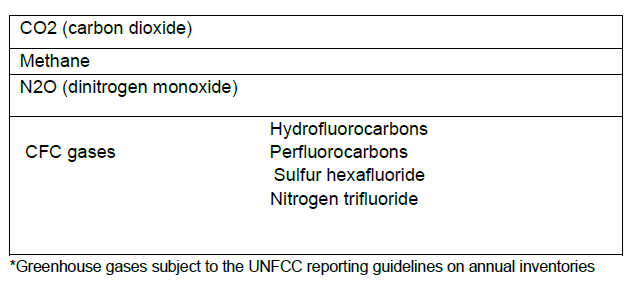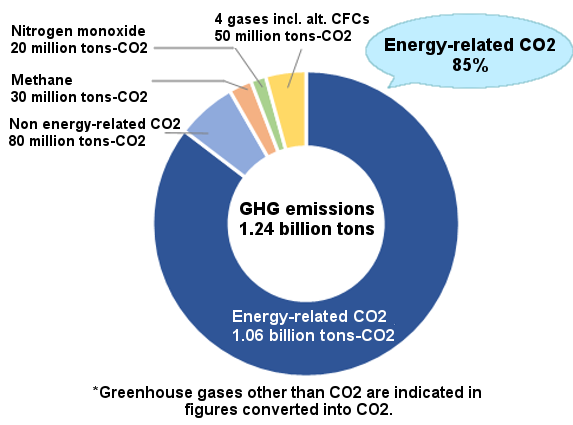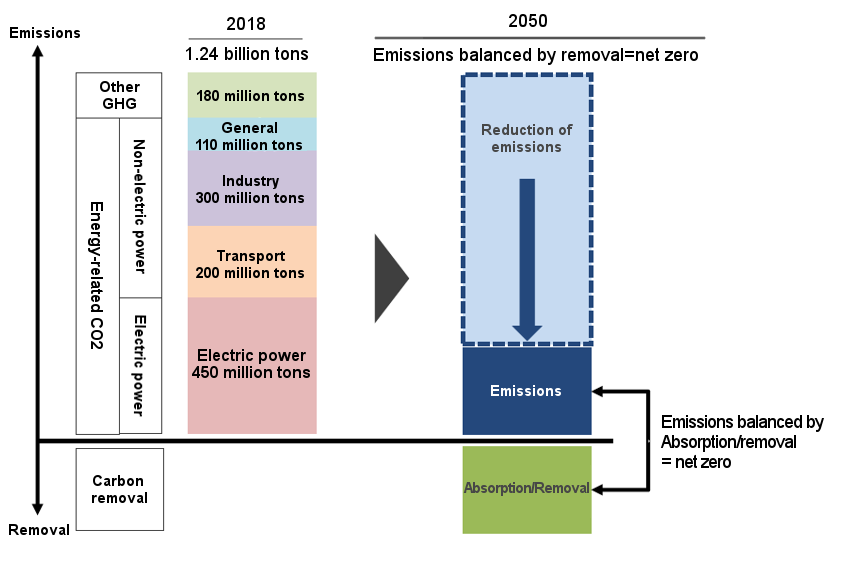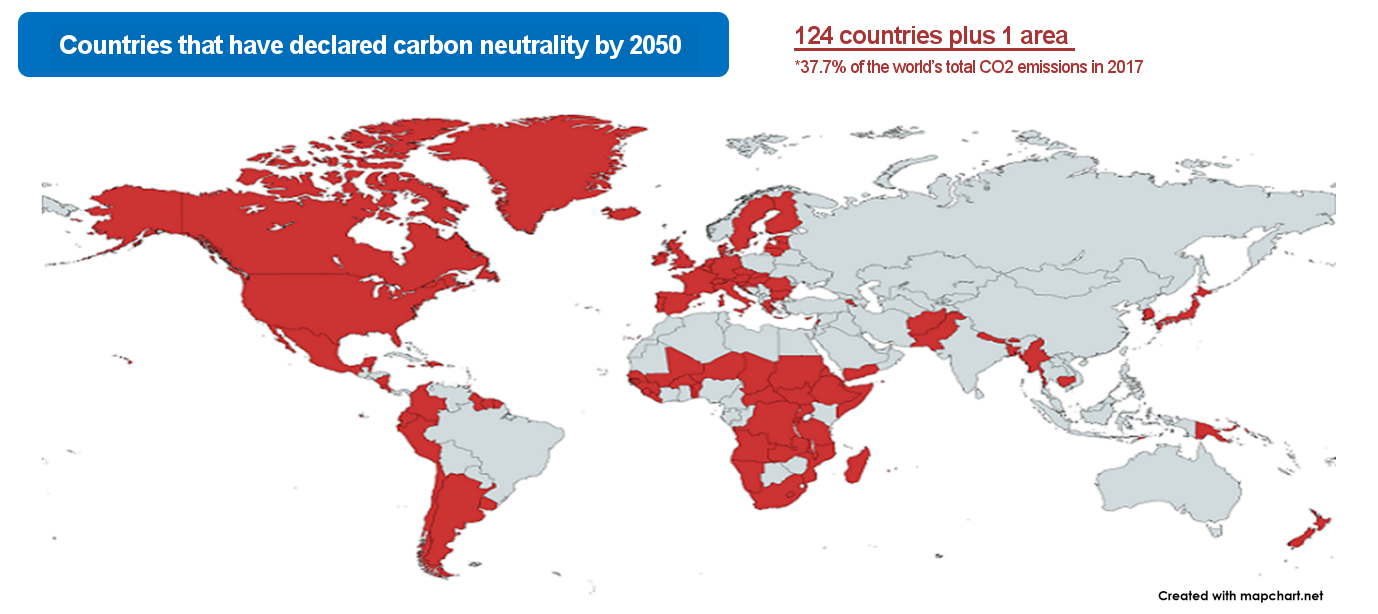What is “Carbon Neutrality” all about? (Part 1)
-Who will realize it, and when?
(in provisional translation)
(English ver.) 2021-08-04

Prime Minister Suga declared “Carbon Neutrality by 2050” at the203rd Session of the Diet in October 2020. Since then, you may have often seen or heard the words “carbon neutrality” in media reports. However, what is “carbon neutrality” in the first place? Many of you will imagine that it involves reducing CO2 emissions, but may have difficulty in giving a clear explanation. This article explains what “carbon neutrality” is all about.
What is carbon neutrality all about?
In order to learn about “carbon neutrality”, let us first look at the statement made by Prime Minister Suga in his general policy speech in October 2020.
“We hereby declare that by 2050 Japan will aim to reduce greenhouse gas emissions to net-zero, that is, to realize a carbon-neutral, decarbonized society.”
It must be noted that a term “greenhouse gas emissions” is used in this statement. “Greenhouse gases” include not only CO2 but methane, N2O (dinitrogen monoxide) and CFC gases as well. “Carbon neutrality” that Japan aims for targets all of these gasses.
Greenhouse gases
Japan’s GHG emissions (2018)
(Source) Created by METI based on the “Data on Japan’s Greenhouse Gas emissions” published by Greenhouse Gas Inventories Office of the National Institute for Environmental Studies
We would also like to draw your attention to the Prime Minister’s statement “net zero greenhouse gas emissions,” which means emissions of greenhouse gases balanced by absorption and removal are to be zero.
It is technically difficult to completely suppress emissions, which should be absorbed or removed aiming to achieve a “net zero” situation. This is what “carbon neutrality” means.
Realizing a “net zero” situation rests on the underlying premise that a substantial reduction in greenhouse gas emissions will be achieved.

(Source) Figures in the left column were created by METI based on the “Data on Japan’s Greenhouse Gas Emissions” published by Greenhouse Gas Inventories Office of the National Institute for Environmental Studies
However, there are a number of sectors where it is difficult to substantially curtail emissions, which should be offset by “absorption” and/or “removal”. Afforestation, for instance, can absorb CO2 from the atmosphere through photosynthesis and store it. Another option will be to use “CCS” (Carbon dioxide Capture and Storage) technology. As an advanced form of CCS, “negative emission technologies” that directly capture CO2 from the atmosphere for storage could be utilized. These include “DACCS” (Direct Air Carbon Capture with Carbon Storage) and “BECCS” (Bio-Energy with Carbon Capture and Storage).
- Examples of negative emission technologies
-
 DACCS (Direct Air Capture with Carbon Storage): A technology to directly capture CO2 from the atmosphere for storage
DACCS (Direct Air Capture with Carbon Storage): A technology to directly capture CO2 from the atmosphere for storage
-
 BECCS (Bioenergy with Carbon Capture and Storage): A technology to capture CO2 from bioenergy combustion for storage
BECCS (Bioenergy with Carbon Capture and Storage): A technology to capture CO2 from bioenergy combustion for storage
When will carbon neutrality need to be achieved?
The Paris Agreement, an international framework to address climate change, has become operational since 2020. It aims to achieve net zero greenhouse gas emissions in the second half of this century.
- Goals of the Paris Agreement
-
 Hold the increase in the global average temperature to well bellow 2°C above pre-industrial levels and pursuing efforts to limit the temperature increase to 1.5°C above pre-industrial levels
Hold the increase in the global average temperature to well bellow 2°C above pre-industrial levels and pursuing efforts to limit the temperature increase to 1.5°C above pre-industrial levels
-
 To pursue the above goals, aim to reach global peak of greenhouse gas emissions as soon as possible and to achieve net zero greenhouse gas emissions in the second half of this century
To pursue the above goals, aim to reach global peak of greenhouse gas emissions as soon as possible and to achieve net zero greenhouse gas emissions in the second half of this century
The Intergovernmental Panel on Climate Change (IPCC), established by UNEP and WMO, issued an “IPCC Special Report on the impacts of global warming of 1.5°C.” According to this report, in order to accomplish the 1.5 degrees C goal (a goal to strive for), it is necessary to achieve carbon neutrality by around 2050.
Against this backdrop, a number of countries are ambitiously raising their targets, leading to the global move toward “carbon neutrality by 2050.”
Who declared “carbon neutrality”?
As of January 20, 2021, 124 countries with Japan included, plus 1 area had declared carbon neutrality by 2050. They account for 37.7% of the world’s total CO2 emissions (energy-derived CO2 in 2017.) A large number of countries including China, which declared carbon neutrality by 2060, have joined the banner of carbon neutrality, accounting for two thirds of the world’s total CO2 emissions.

(Source) Created by METI based on the Climate Ambition Alliance at COP25, submissions of long-term strategies to the United Nations, and other data (As of January 20, 2021)
In addition to countries, there are an increasing number of enterprises aiming for carbon neutrality.
A number of Japanese companies have also declared carbon neutrality. What kind of efforts are they making toward carbon neutrality by 2050?
Part 2 of this article will focus on rationale and strategies for achieving carbon neutrality by 2050.
Division in charge
About the article
Global Environmental Affairs Office, Industrial Science and Technology Policy and Environment Bureau, METI
About Special Contents
Research and Public Relations Office, Policy Planning and Coordination Division, Commissioner’s Secretariat, ANRE
![]() The original Japanese text of this article; Click here
The original Japanese text of this article; Click here